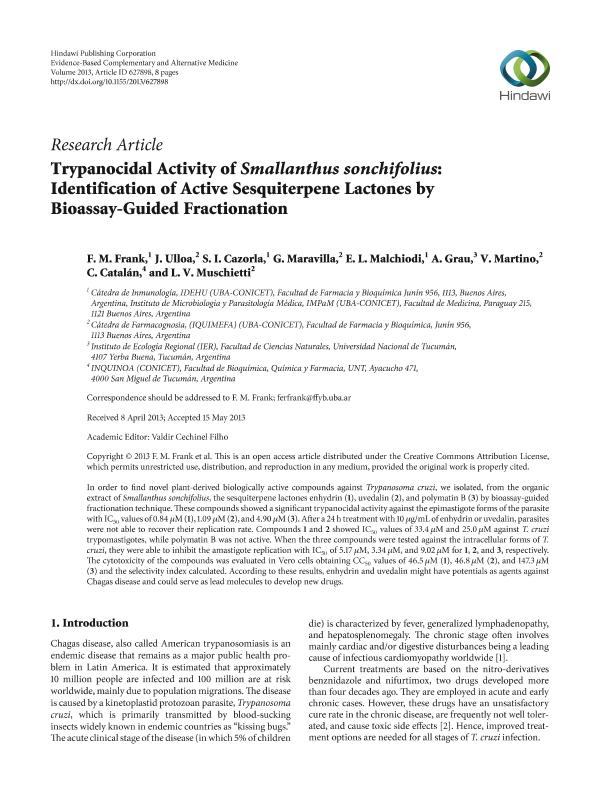Artículo
Trypanocidal Activity of Smallanthus sonchifolius. Identification of Active Sesquiterpene Lactones by Bioassay-Guided Fractionation.
Frank, Fernanda Maria ; Ulloa, Jerónimo Luis
; Ulloa, Jerónimo Luis ; Cazorla, Silvia Ines
; Cazorla, Silvia Ines ; Maravilla, G.; Malchiodi, Emilio Luis
; Maravilla, G.; Malchiodi, Emilio Luis ; Grau, A.; Martino, Virginia Susana
; Grau, A.; Martino, Virginia Susana ; Catalan, Cesar Atilio Nazareno
; Catalan, Cesar Atilio Nazareno ; Muschietti, Liliana
; Muschietti, Liliana
 ; Ulloa, Jerónimo Luis
; Ulloa, Jerónimo Luis ; Cazorla, Silvia Ines
; Cazorla, Silvia Ines ; Maravilla, G.; Malchiodi, Emilio Luis
; Maravilla, G.; Malchiodi, Emilio Luis ; Grau, A.; Martino, Virginia Susana
; Grau, A.; Martino, Virginia Susana ; Catalan, Cesar Atilio Nazareno
; Catalan, Cesar Atilio Nazareno ; Muschietti, Liliana
; Muschietti, Liliana
Fecha de publicación:
06/2013
Editorial:
Oxford University Press
Revista:
Evidence-based Complementary And Alternative Medicine
ISSN:
1741-427X
e-ISSN:
1741-4288
Idioma:
Inglés
Tipo de recurso:
Artículo publicado
Clasificación temática:
Resumen
In order to find novel plant-derived biologically active compounds against Trypanosoma cruzi, we isolated, from the organic extract of Smallanthus sonchifolius, the sesquiterpene lactones enhydrin (1), uvedalin (2), and polymatin B (3) by bioassay-guided fractionation technique. These compounds showed a significant trypanocidal activity against the epimastigote forms of the parasite with IC50 values of 0.84 μM (1), 1.09 μM (2), and 4.90 μM (3). After a 24 h treatment with 10 μg/mL of enhydrin or uvedalin, parasites were not able to recover their replication rate. Compounds 1 and 2 showed IC50 values of 33.4 μM and 25.0 μM against T. cruzi trypomastigotes, while polymatin B was not active. When the three compounds were tested against the intracellular forms of T. cruzi, they were able to inhibit the amastigote replication with IC50 of 5.17 μM, 3.34 μM, and 9.02 μM for 1, 2, and 3, respectively. The cytotoxicity of the compounds was evaluated in Vero cells obtaining CC50 values of 46.5 μM (1), 46.8 μM (2), and 147.3 μM (3) and the selectivity index calculated. According to these results, enhydrin and uvedalin might have potentials as agents against Chagas disease and could serve as lead molecules to develop new drugs.
Archivos asociados
Licencia
Identificadores
Colecciones
Articulos(IDEHU)
Articulos de INST.DE EST.DE LA INMUNIDAD HUMORAL PROF.R.A.MARGNI
Articulos de INST.DE EST.DE LA INMUNIDAD HUMORAL PROF.R.A.MARGNI
Citación
Frank, Fernanda Maria; Ulloa, Jerónimo Luis; Cazorla, Silvia Ines; Maravilla, G.; Malchiodi, Emilio Luis; et al.; Trypanocidal Activity of Smallanthus sonchifolius. Identification of Active Sesquiterpene Lactones by Bioassay-Guided Fractionation.; Oxford University Press; Evidence-based Complementary And Alternative Medicine; 6278; 6-2013; 1-10
Compartir
Altmétricas



